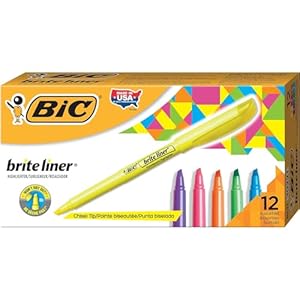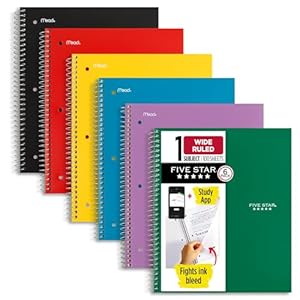There’s one thing so candy about poems for third graders. The children are able to deal with extra advanced themes and vocabulary, however the poetry continues to be so endearing and harmless. We’ve put collectively an inventory of participating poems that can delight and spark a dialog amongst your third grade college students.
FREE PRINTABLE
Free Poetry Worksheet Bundle
Seize our poetry worksheet bundle to pair along with your poetry unit and make educating poetry enjoyable and easy.
1. Daisies by Frank Dempster Sherman
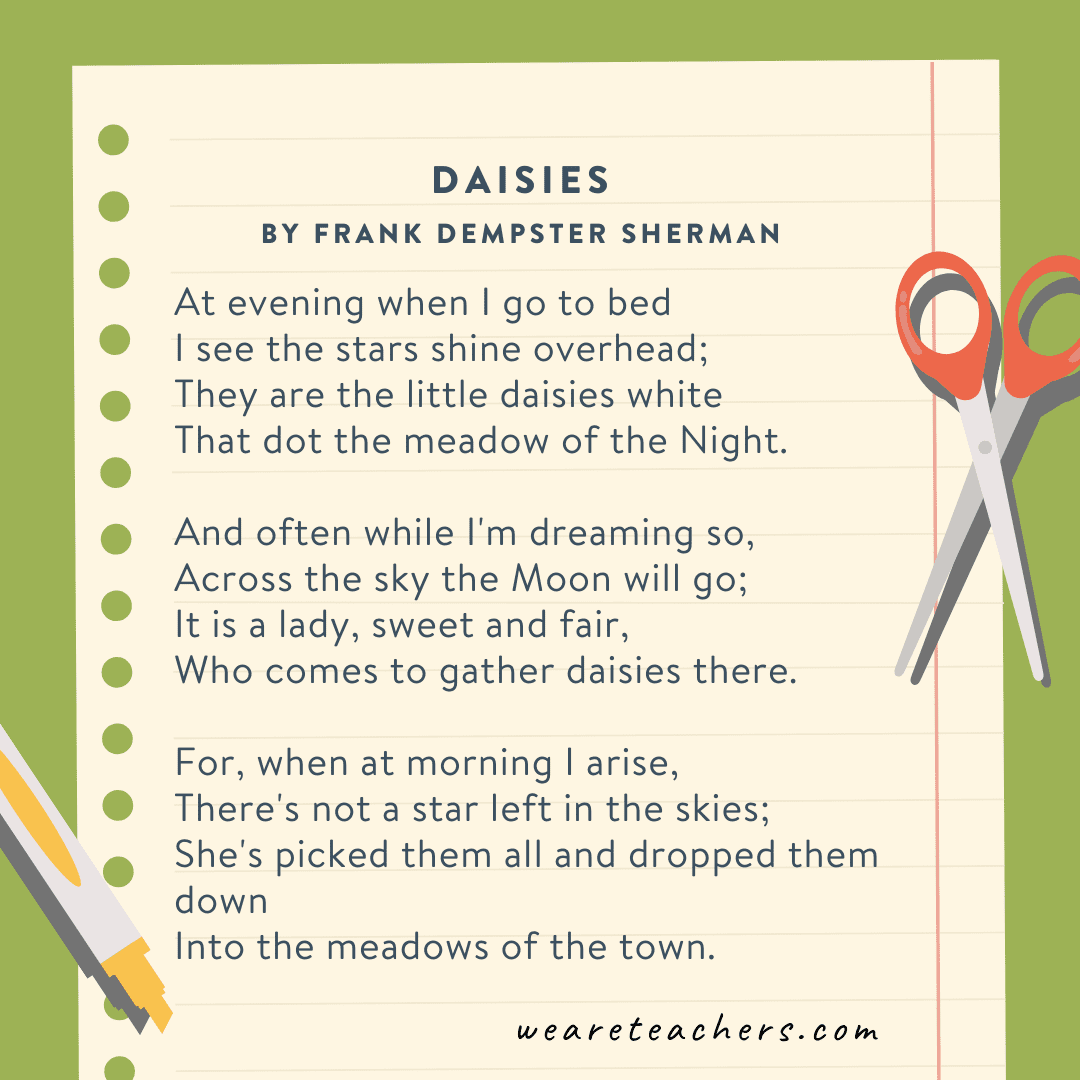
“It’s a girl, candy and honest, who comes to collect daisies there.”
Themes: Nature, magnificence, appreciation
Literary units: Imagery, personification, rhyme
This mild poem paints a picturesque scene of a girl choosing daisies, utilizing vivid imagery and a melodic rhyme scheme. It’s a stunning alternative for introducing college students to conventional poetic construction whereas encouraging discussions about how nature is widely known in poetry.
“The faculties at the moment are open however, this yr, at mine, the lecturers and college students are assembly on-line.”
Themes: Adaptation, humor, fashionable life
Literary units: Rhyme, tone, satire
This lighthearted poem captures the expertise of on-line studying with humor and relatability. It’s nice for discussing how poetry can replicate modern life and for exploring rhyme and tone in humorous poetry.
3. Little Rain by Elizabeth Madox Roberts
“Once I was making myself a recreation, up within the backyard, a bit rain got here.”
Themes: Childhood, nature, surprising moments
Literary units: Imagery, rhythm, simplicity
This brief, candy poem captures a baby’s playful interplay with nature, making it a strong for discussing sensory particulars and the way poetry can remodel easy moments into one thing particular.
“I’d take it, spare it, give it, share it, lend it, spend it, too.”
Themes: Generosity, love, kindness
Literary units: Repetition, rhythm, parallelism
This uplifting poem emphasizes the concept of spreading love generously, utilizing repetition and rhythm to create a flowing, musical impact. It’s a great way to debate the facility of poetic construction in reinforcing that means and emotion.
5. To a Child by William Wordsworth
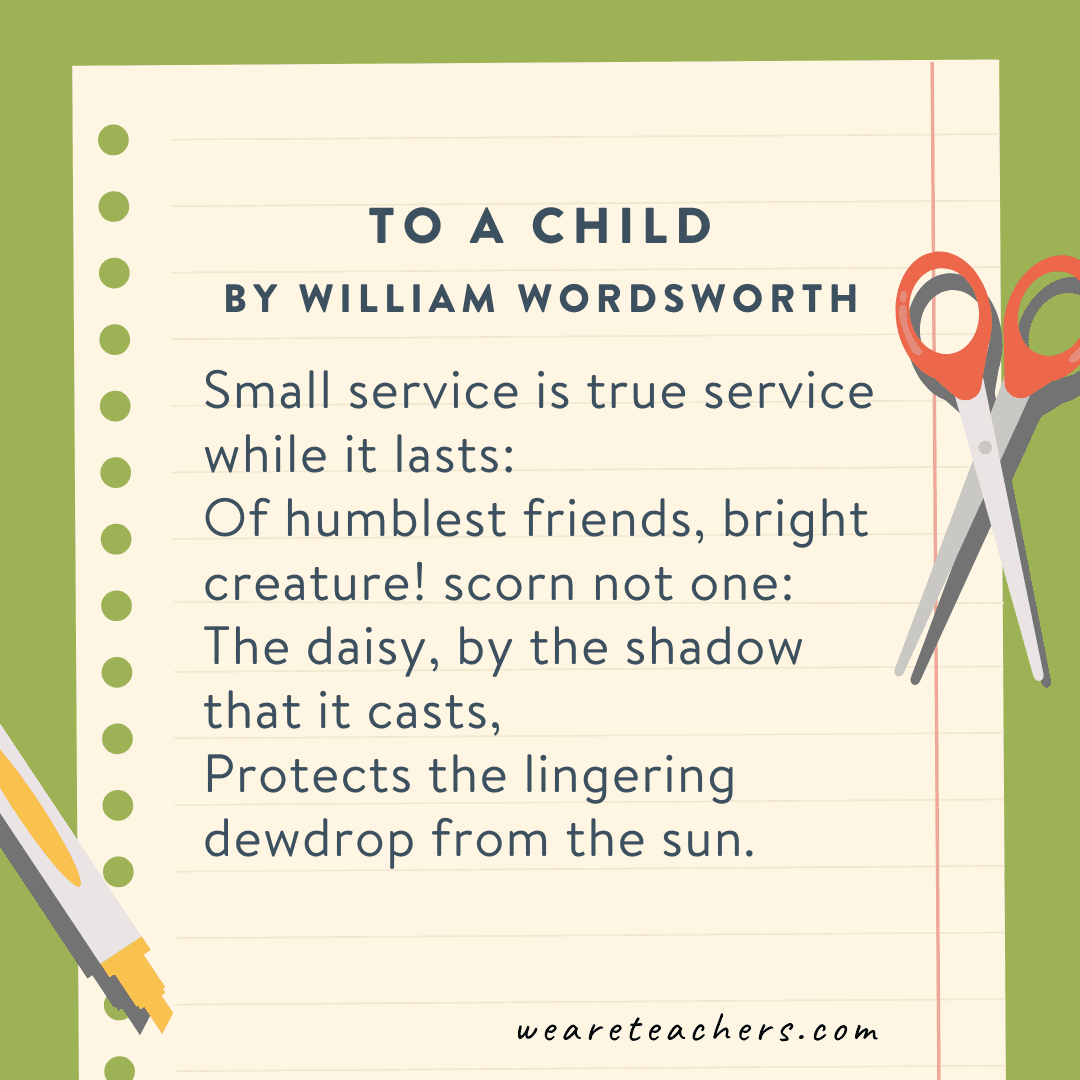
“Small service is true service whereas it lasts …”
Themes: Kindness, humility, knowledge
Literary units: Aphorism, tone, metaphor
This considerate poem provides knowledge concerning the worth of small acts of kindness, making it a terrific dialog starter about ethical classes in poetry. It’s additionally helpful for exploring how poets use easy language to convey deep truths.
“Unhealthy canines barking loud, large ghosts in a cloud / Life doesn’t frighten me in any respect.”
Themes: Braveness, resilience, childhood fears
Literary units: Repetition, rhyme, imagery
This daring, rhythmic poem expresses confidence within the face of concern, utilizing sturdy imagery and repetition to create a way of empowerment. It’s excellent for discussions on how poetry can encourage resilience and self-assurance whereas additionally exploring rhythm and voice in poetry.
“On a bench, in Joe’s little shed, mendacity not too far aside, had been his ax and his switchblade, having a quiet heart-to-heart.”
Themes: Energy vs. precision, knowledge, storytelling
Literary units: Personification, dialogue, metaphor
This intelligent poem turns instruments into characters, utilizing personification to discover the distinction between brute energy and sharp precision. It’s an attention-grabbing technique to introduce college students to metaphor and symbolism whereas sparking discussions on how objects can inform a narrative.
8. The Eagle by Alfred, Lord Tennyson
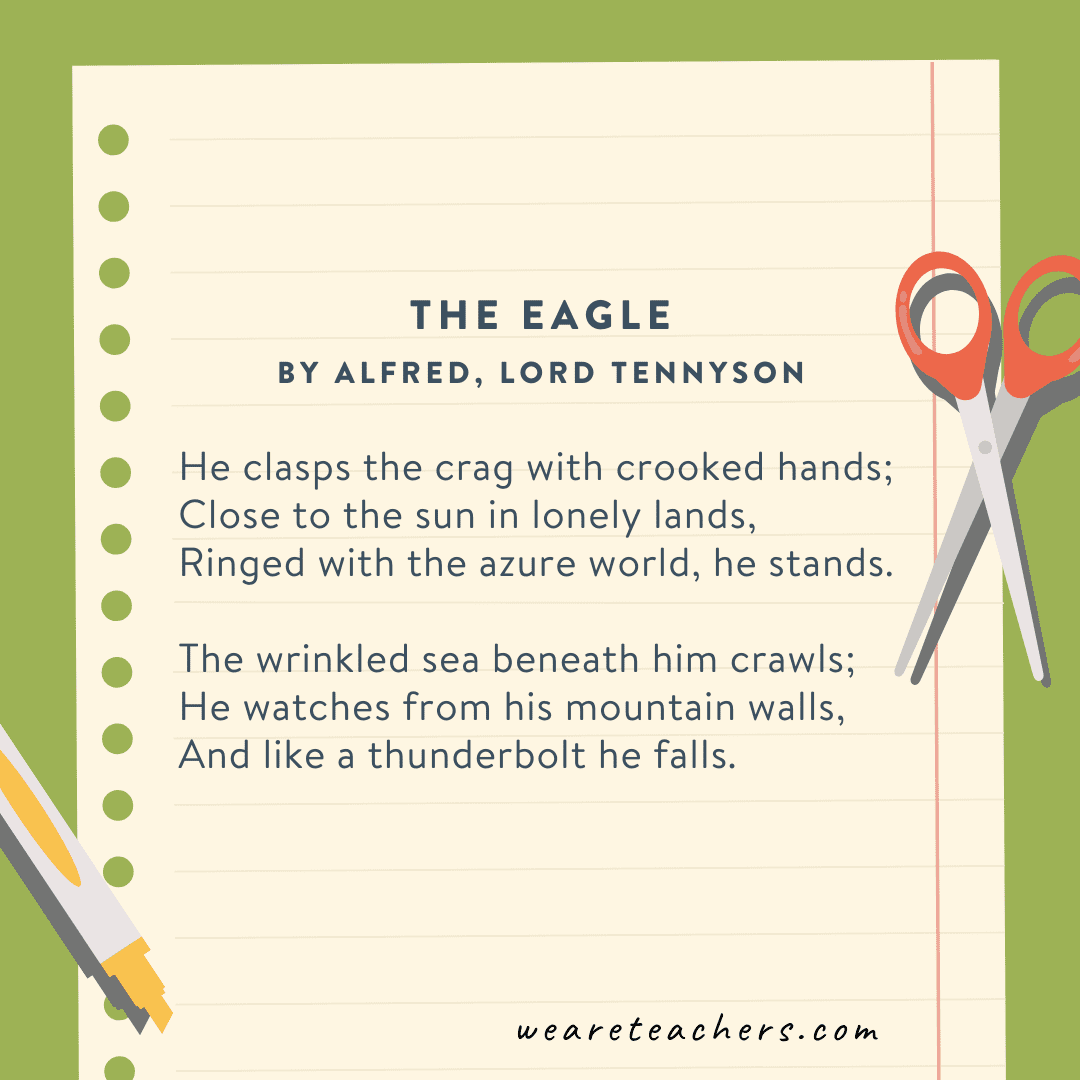
“He clasps the crag with crooked fingers …”
Themes: Energy, nature, isolation
Literary units: Alliteration, imagery, personification
This brief but highly effective poem paints a vivid image of an eagle surveying its environment earlier than diving. It’s a terrific instance of how poets use sturdy imagery and alliteration to create depth and can be utilized to debate themes of energy and independence.
“See the gorgeous snowflakes, falling from the sky. / On the wall and housetops, gentle and thick they lie.”
Themes: Nature, winter, magnificence
Literary units: Rhyme, repetition, sensory imagery
This mild winter poem makes use of easy language to seize the peaceable great thing about falling snow. It’s a candy technique to introduce youthful college students to rhyme and sensory particulars whereas encouraging them to explain seasonal experiences in their very own phrases.
10. The Dolly by Jeanette Cheal
“The dolly sat upon the shelf / within the toy maker’s store all by herself.”
Themes: Loneliness, incapacity, hope
Literary units: Personification, rhyme, tone
This touching poem offers a doll human feelings, making it a beautiful instance of personification. It’s a strong choose for discussing how writers create emotion in poetry and the way objects can replicate human emotions.
11. The Snowflake by Margaret Elizabeth Sangster
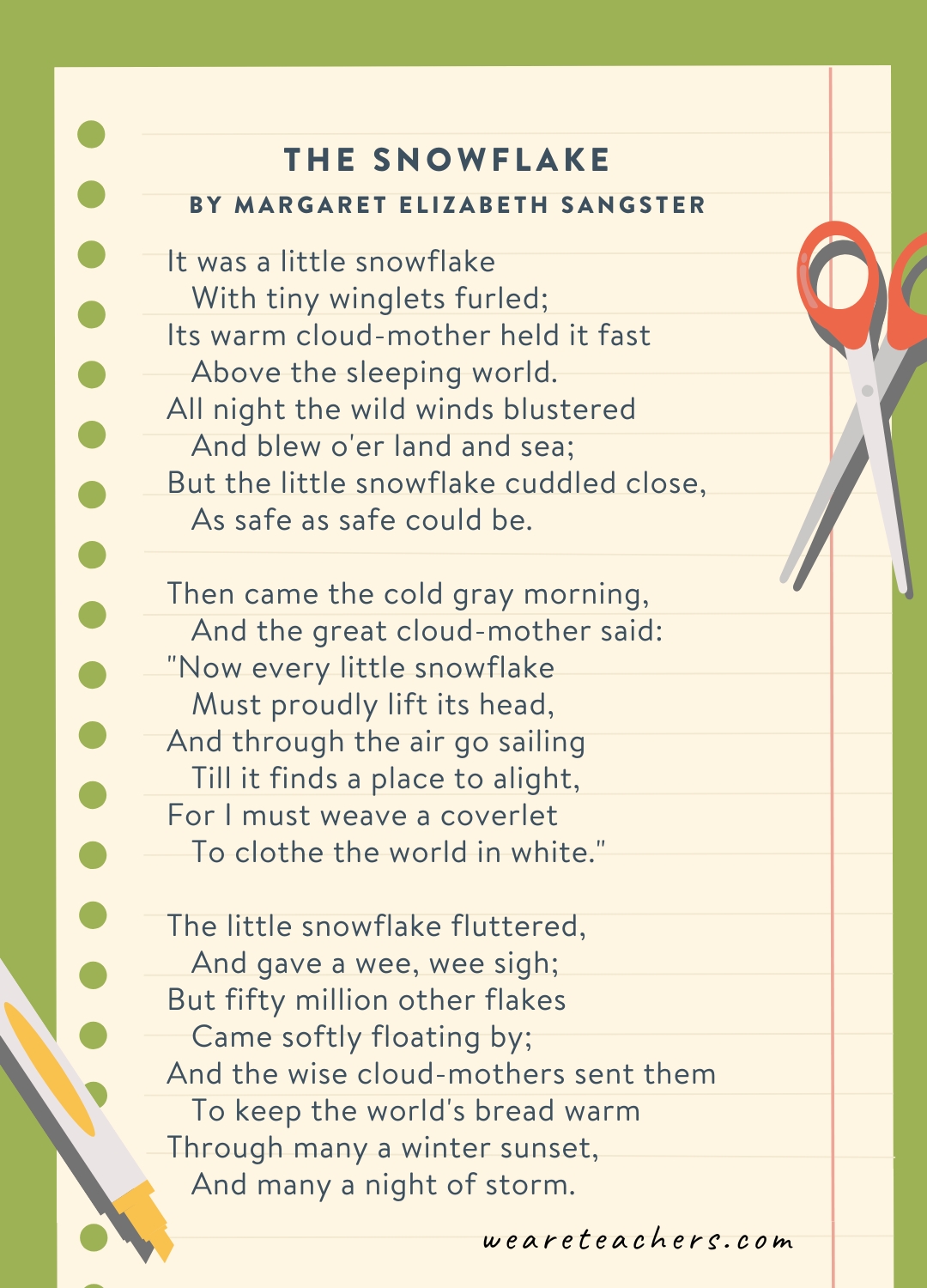
“It was a bit snowflake …”
Themes: Nature, uniqueness, fleeting magnificence
Literary units: Imagery, personification, symbolism
This delicate poem captures the wonder and transience of a single snowflake, making it a terrific alternative for discussing how poets use imagery to explain nature. It’s additionally an exquisite technique to introduce college students to themes of individuality and impermanence.
“Frosty is the morning / However the solar is shiny …”
Themes: Pleasure, childhood, winter enjoyable
Literary units: Rhyme, rhythm, sensory imagery
This energetic poem brings a winter morning to life, celebrating the fun of sledding down a hill. It’s a terrific choose for exploring rhyme and rhythm whereas encouraging college students to put in writing about their very own out of doors adventures.
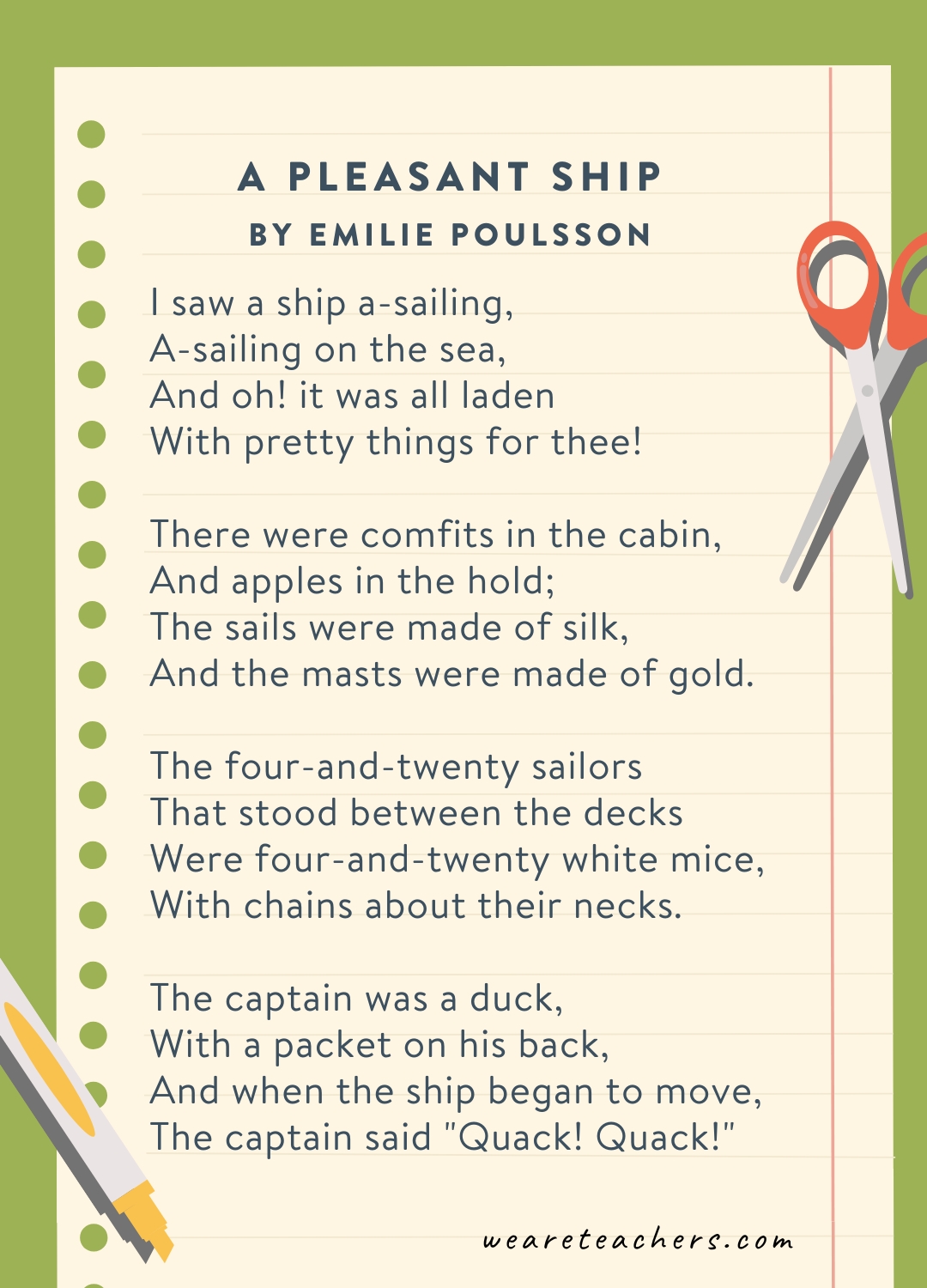
“I noticed a ship a-sailing …”
Themes: Creativeness, journey, childhood marvel
Literary units: Repetition, personification, rhyme
This whimsical poem turns a easy commentary right into a magical journey, making it a great way to discover creativeness in poetry. It’s additionally helpful for educating how rhyme and repetition create a musical high quality in verse.
“I do know what I’d do.”
Themes: Kindness, generosity, optimism
Literary units: Personification, metaphor, repetition
This uplifting poem imagines the speaker as a sunbeam spreading heat and kindness, providing a beautiful lesson on empathy and optimistic motion. It’s nice for discussing how poets use metaphor to precise deeper themes.
“Glad to see you, little chook / ’Twas your little chirp I heard …”
Themes: Nature, appreciation, companionship
Literary units: Rhyme, imagery, tone
This mild poem highlights the easy pleasure of noticing a sparrow’s presence, making it instance of how poetry can discover magnificence in on a regular basis moments. It’s excellent for exploring descriptive language and the theme of appreciating nature.
“However I’m undecided if it’s good. / It doesn’t have the issues / my instructor says a poem ought to.”
Literary units: Rhyme, irony, meta-poetry
This humorous, self-aware poem pokes enjoyable at poetry guidelines whereas celebrating the act of writing. It’s a humorous technique to encourage college students to experiment with their very own poetry, exhibiting that creativity issues simply as a lot as construction.
“The spider wears a plain brown costume …”
Themes: Interior magnificence, character, knowledge
Literary units: Metaphor, distinction, symbolism
This thought-provoking poem contrasts outward look with inside goodness, utilizing the standard spider as a metaphor. It’s a incredible alternative for discussing the theme of true magnificence and the way poets use easy imagery to convey deeper messages.
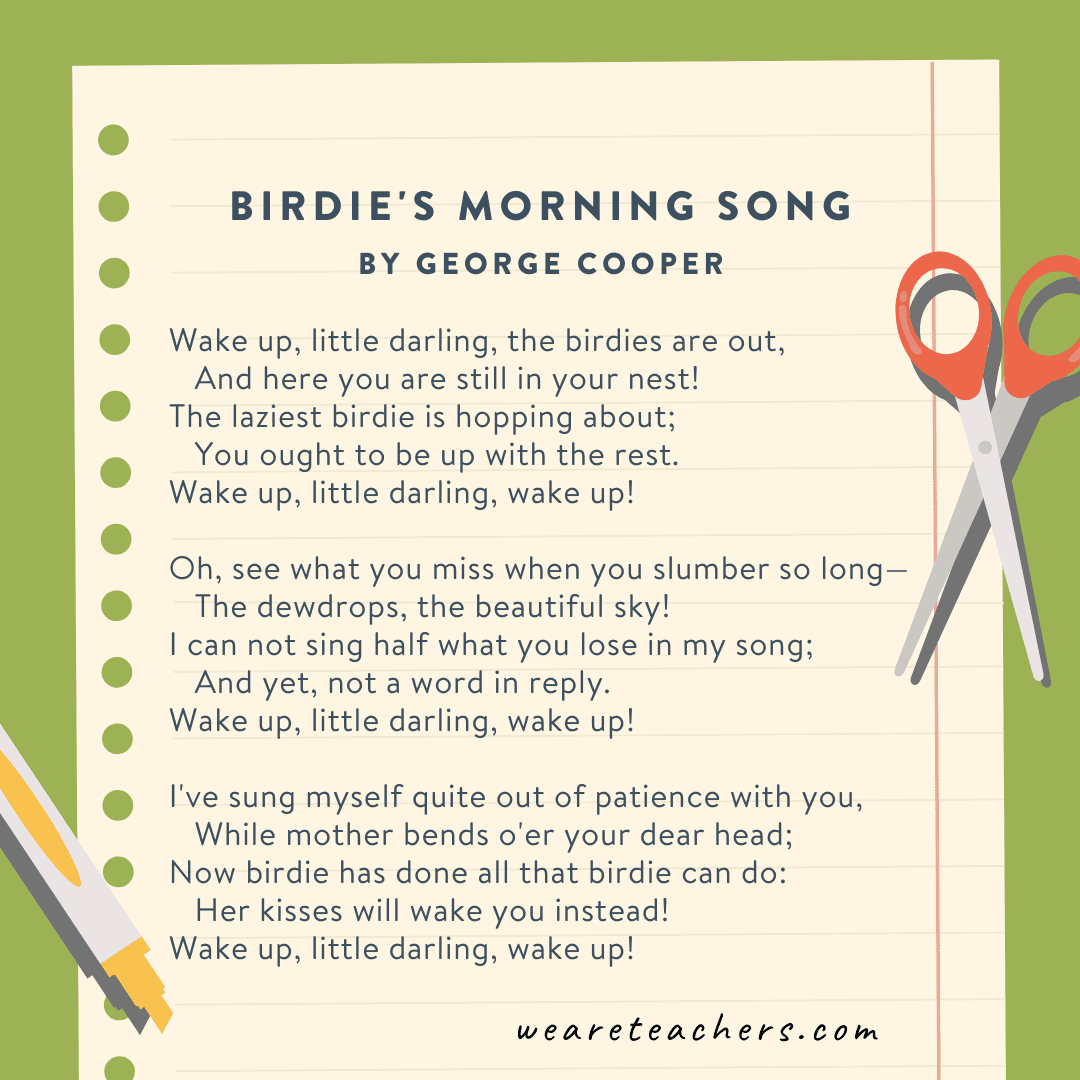
“Get up, little darling, the birdies are out …”
Themes: Nature, pleasure, new beginnings
Literary units: Rhyme, personification, repetition
This candy, musical poem captures the cheerful begin of a brand new day via the eyes of a chook. It’s excellent for introducing younger college students to rhyme and rhythm whereas sparking discussions about nature and morning routines.
19. Trees by Joyce Kilmer
“I feel that I shall by no means see / A poem pretty as a tree …”
Themes: Nature, appreciation, spirituality
Literary units: Rhyme, personification, metaphor
This well-known poem celebrates the wonder and grandeur of bushes, personifying them to focus on their pure grace. It’s a terrific piece for discussing poetic construction, figurative language, and the theme of reverence for nature.
“There’s a little maiden— / Who’s she? Are you aware?”
Themes: Positivity, kindness, character
Literary units: Rhyme, imagery, tone
This uplifting poem highlights the facility of a cheerful angle, making it a good selection for discussing how poetry can convey ethical classes. It additionally serves as instance of how tone and phrase alternative form the message of a poem.
“Which manner does the wind blow? / And the place does he go?”
Themes: Curiosity, nature, thriller
Literary units: Personification, repetition, rhyme
This straightforward but considerate poem captures a childlike curiosity concerning the wind’s motion, making it a good selection for discussing personification and the way poetry can discover on a regular basis wonders. It’s additionally helpful for encouraging college students to watch and describe nature in their very own writing.
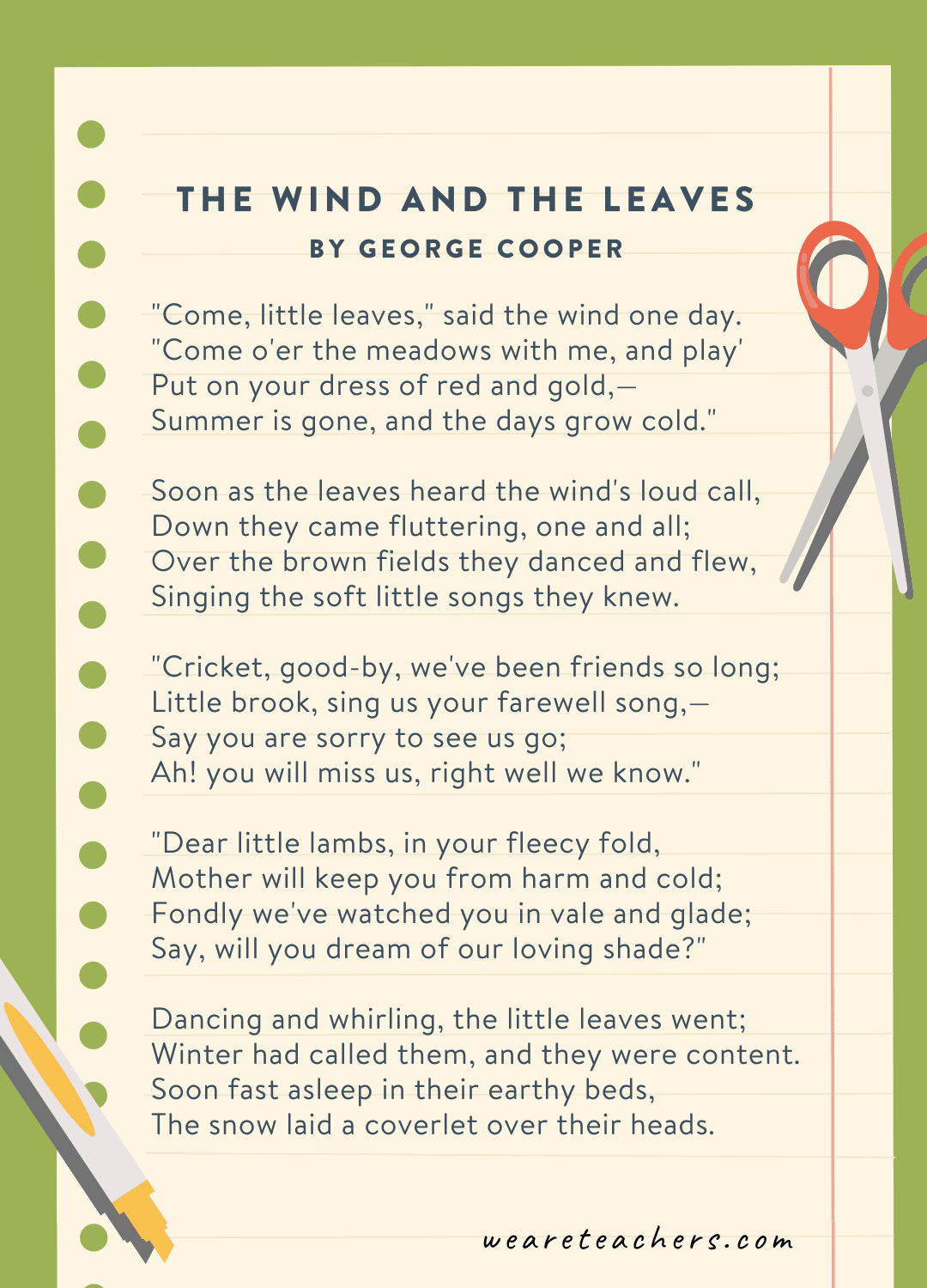
“‘Come, little leaves,’ stated the wind in the future.”
Themes: Change, seasons, nature’s cycle
Literary units: Dialogue, personification, imagery
This charming poem tells a narrative of autumn utilizing personification, making it a beautiful instance of how poets deliver nature to life. It’s excellent for educating figurative language and for seasonal poetry actions.
23. Lullaby by Alfred, Lord Tennyson
“Candy and low, candy and low …”
Themes: Love, consolation, bedtime
Literary units: Repetition, rhythm, imagery
This mild lullaby poem has a relaxing rhythm and gentle, flowing phrases, making it excellent for discussing how sound and construction affect temper. It’s nice for exploring how poets use repetition, tone, and imagery to create emotion.
24. March by Mary Mapes Dodge
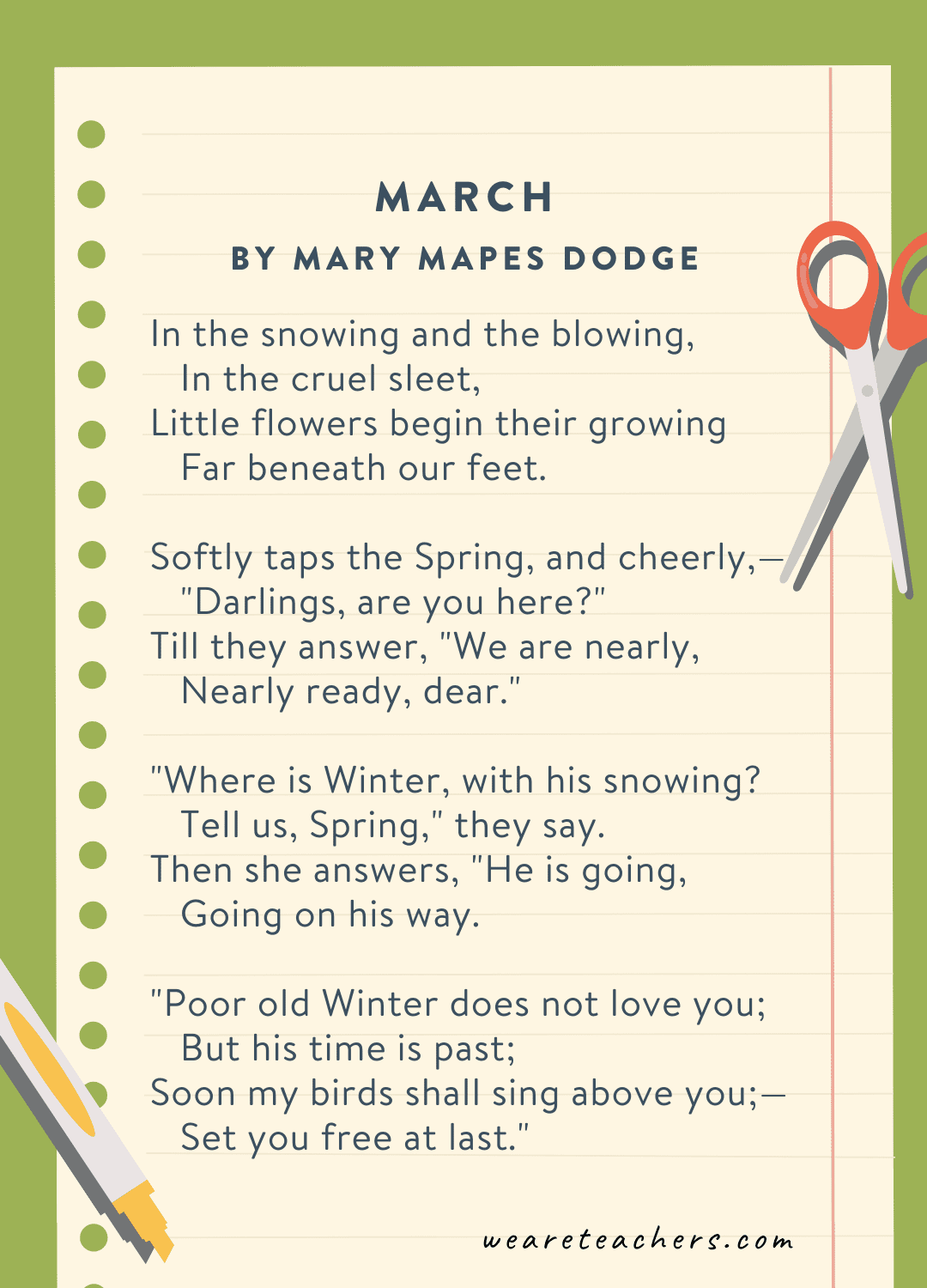
“Within the snowing and the blowing …”
Themes: Climate, transition, resilience
Literary units: Rhyme, repetition, imagery
This energetic poem captures the unpredictable nature of March, making it a strong choose for exploring how rhythm and phrase alternative replicate motion and power. It’s additionally helpful for discussing seasonal adjustments and the way poetry can describe the climate in a vivid manner.
25. The Rabbit by Elizabeth Madox Roberts
“Once they stated the time to cover was mine / I hid again beneath a thick grape vine.”
Themes: Childhood, play, nature
Literary units: Imagery, perspective, rhythm
This playful poem brings readers into the world of a kid hiding in a recreation, making it instance of how poetry captures on a regular basis moments. It’s excellent for discussing perspective in poetry and inspiring college students to put in writing about their very own childhood experiences.
“I scrape a leg / Or pores and skin a knee.”
Themes: Journey, childhood, nature
Literary units: Rhyme, repetition, sensory imagery
This energetic poem captures the fun and minor mishaps of climbing bushes, making it a becoming piece for discussing sensory imagery and the way poetry displays childhood experiences. It’s additionally helpful for exploring rhythm and rhyme in storytelling poetry.
“I studied my tables time and again, and , too …”
Themes: Embarrassment, studying, perseverance
Literary units: Narrative construction, rhythm, irony
This relatable poem humorously recounts the frustration of creating a mistake regardless of cautious preparation. It’s a good way to debate how poetry can inform a narrative and the way humor can be utilized to precise common experiences.
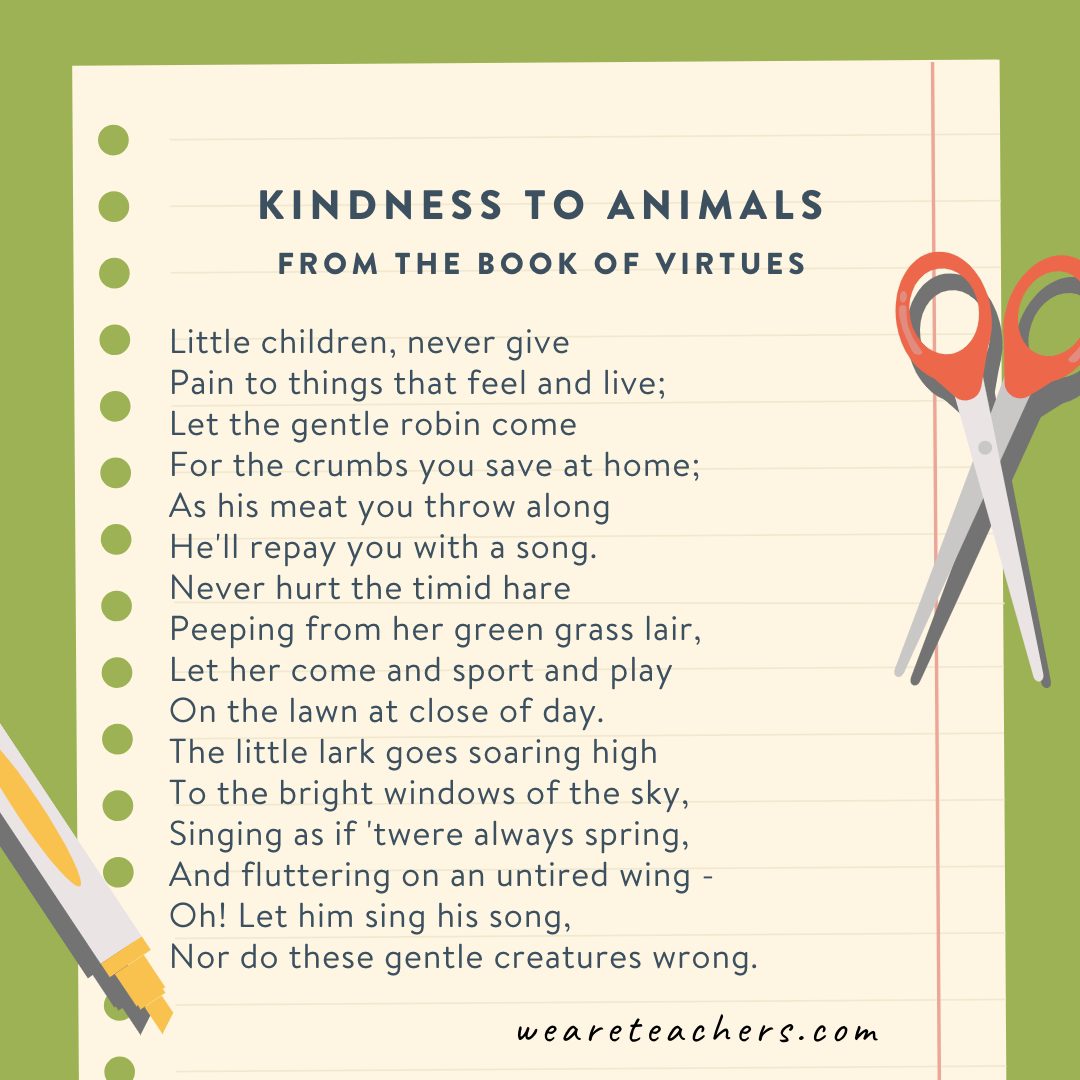
“Little kids, by no means give / Ache to issues that really feel and stay …”
Themes: Compassion, morality, accountability
Literary units: Rhyme, repetition, direct deal with
This brief and significant poem teaches an vital lesson about kindness towards animals, making it a really perfect piece for discussions on poetry with ethical themes. It’s additionally helpful for exploring how rhyme and repetition reinforce a message.
29. Be Kind by Alice Joyce Davidson
“Just a bit little bit of kindness / Can go a protracted, good distance …”
Themes: Empathy, generosity, optimistic actions
Literary units: Rhyme, repetition, uplifting tone
This poem encourages kindness via easy, heartfelt language, making it a terrific alternative for discussing how poetry can encourage optimistic conduct. It additionally serves as instance of how construction and repetition create an impactful message.
“Nobody throws a pencil / on the ceiling of the category.”
Themes: Humor, mischief, college life
Literary units: Rhyme, irony, exaggeration
This playful poem humorously describes the antics that occur when the instructor isn’t watching, making it a enjoyable technique to have interaction college students with poetry. It’s excellent for discussing exaggeration, humor in poetry, and the way rhyme enhances comedic impact.
“Jellicle Cats come out tonight / Jellicle Cats come one come all.”
Themes: Thriller, motion, playfulness
Literary units: Rhyme, repetition, imagery
This energetic poem creates a energetic, virtually musical ambiance because it describes the Jellicle Cats. It’s nice for discussing how rhythm and repetition construct momentum in poetry and for introducing college students to Eliot’s playful use of language.
“Whose woods these are I feel I do know …”
Themes: Reflection, solitude, obligation
Literary units: Rhyme, imagery, symbolism
This well-known poem captures a quiet, reflective second in nature whereas hinting at deeper meanings of accountability and relaxation. It’s a wonderful piece for discussing symbolism, rhyme scheme (the interlocking rubaiyat), and the way poetry evokes emotion via simplicity.
33. Your World by Georgia Douglas Johnson
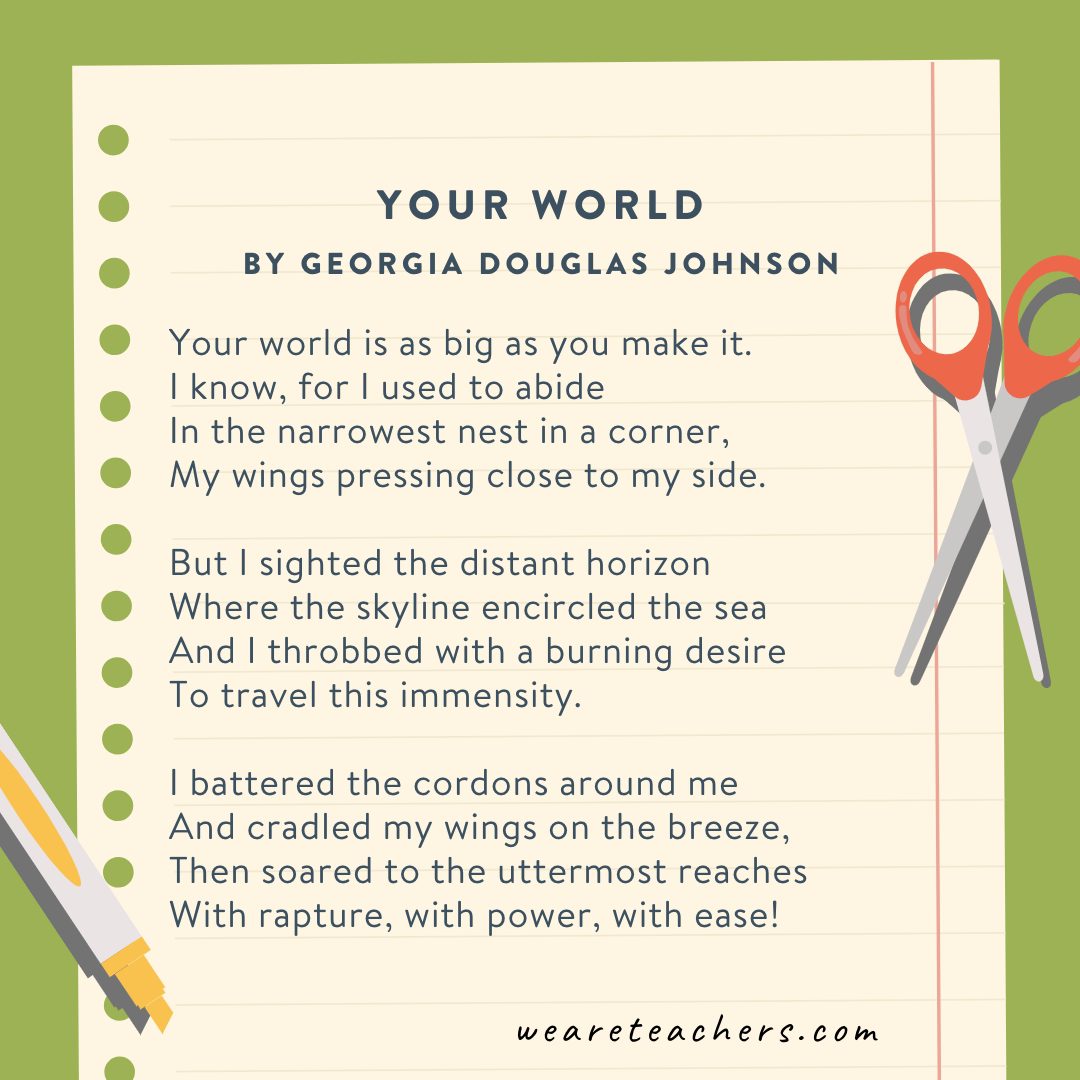
“Your world is as large as you make it.”
Themes: Ambition, braveness, private progress
Literary units: Metaphor, imagery, motivational tone
This uplifting poem encourages readers to interrupt free from limitations and embrace potentialities. It’s a strong alternative for discussing metaphor and inspirational themes, in addition to for connecting poetry to college students’ private desires and aspirations.
“They went to sea in a Sieve, they did / In a sieve they went to sea …”
Themes: Journey, nonsense, willpower
Literary units: Rhyme, repetition, nonsense phrases
This pleasant nonsense poem is stuffed with playful language and absurd imagery, making it excellent for exploring rhyme, rhythm, and the style of nonsense poetry. It’s additionally good for sparking creativity and imaginative storytelling.
“It was time to go.”
Themes: Change, intuition, nature’s cycle
Literary units: Personification, imagery, foreshadowing
This fantastically written poem captures the quiet inevitability of seasonal change via the migration of geese. It’s a terrific piece for discussing personification and the way poets use nature to discover deeper themes of intuition and transition.
“I’m making a pizza the dimensions of the solar / a pizza that’s certain to weigh greater than a ton …”
Themes: Exaggeration, humor, creativity
Literary units: Hyperbole, rhyme, repetition
This enjoyable and over-the-top poem takes an on a regular basis meals and turns it into a large, ridiculous creation. It’s great for educating hyperbole and rhyme, and it could actually encourage college students to put in writing their very own exaggerated poems about meals or different acquainted subjects.
“Went for a experience in a flying shoe …”
Themes: Journey, nonsense, creativeness
Literary units: Rhyme, rhythm, nonsense phrases
This whimsical poem takes readers on a wild, dreamlike journey in a flying shoe, making it excellent for exploring nonsense poetry and rhythm. It’s additionally a great way to encourage college students to embrace creativity and playful language in their very own writing.
38. My Shadow by Robert Louis Stevenson
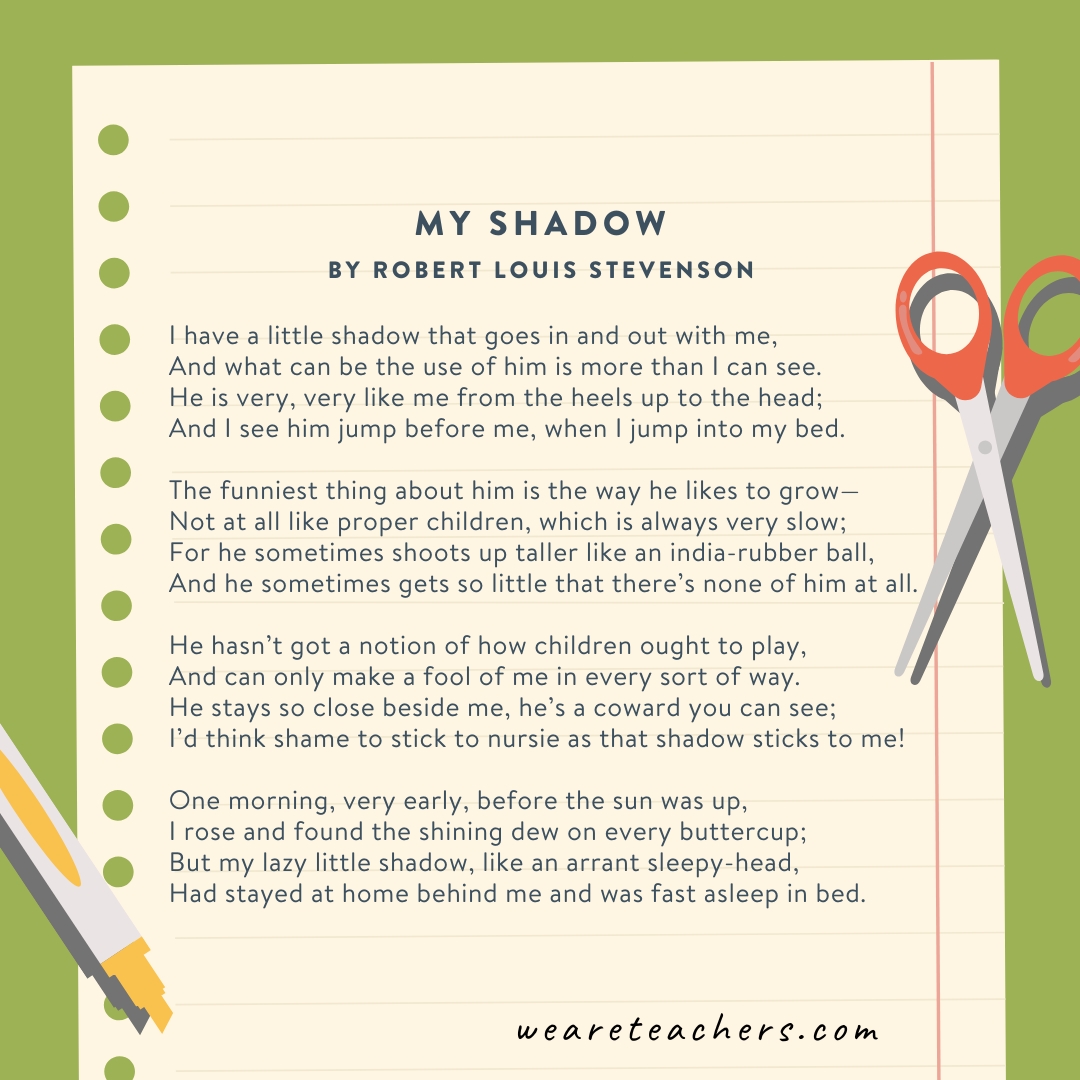
“I’ve a bit shadow that goes out and in with me …”
Themes: Childhood, curiosity, commentary
Literary units: Personification, rhyme, rhythm
This traditional poem captures a baby’s fascination with their very own shadow, making it a strong piece for discussing personification and the way poetry can replicate the way in which kids observe the world. It’s additionally helpful for exploring rhyme and rhythm in conventional poetry.
“’Twas brillig, and the slithy toves / Did gyre and gimble within the wabe …”
Themes: Braveness, creativeness, journey
Literary units: Alliteration, portmanteau, rhyme
This well-known nonsense poem is stuffed with made-up phrases and vivid imagery, making it excellent for educating artistic writing, wordplay, and the way that means could be inferred via context. It’s additionally good for introducing literary units like alliteration and neologisms.
“There’s a brand new child on the block / and boy, that child is hard …”
Themes: Humor, exaggeration, college life
Literary units: Hyperbole, rhyme, tone
This humorous poem describes an unbelievably powerful new scholar, utilizing exaggeration to construct suspense and shock. It’s a enjoyable technique to educate hyperbole and rhyme whereas additionally participating college students with a relatable college setting.
41. The Tyger by William Blake
“Tyger Tyger, burning shiny / Within the forests of the evening …”
Themes: Creation, energy, thriller, duality
Literary units: Symbolism, repetition, rhyme, alliteration
This traditional poem questions the character of creation, utilizing the tiger as a robust and virtually divine determine. It’s nice for discussing symbolism, contrasting imagery (the tiger vs. the lamb in Blake’s poetry), and the way repetition enhances that means.
“I’m going out to fetch the little calf / That’s standing by the mom. It’s so younger …”
Themes: Nature, simplicity, renewal
Literary units: Imagery, repetition, conversational tone
This mild, welcoming poem invitations the reader right into a quiet second in nature. It’s excellent for exploring Frost’s signature fashion of simplicity and pure imagery, in addition to discussing how poetry can seize on a regular basis moments fantastically.
“The outlook wasn’t sensible for the Mudville 9 that day: / The rating stood 4 to 2, with however one inning extra to play …”
Themes: Confidence, disappointment, sportsmanship
Literary units: Narrative construction, rhythm, suspense, irony
This dramatic, beloved baseball poem builds pleasure with its storytelling and in the end delivers a twist ending. It’s incredible for analyzing narrative poetry, discussing how poets use suspense, and exploring themes of confidence and humility.
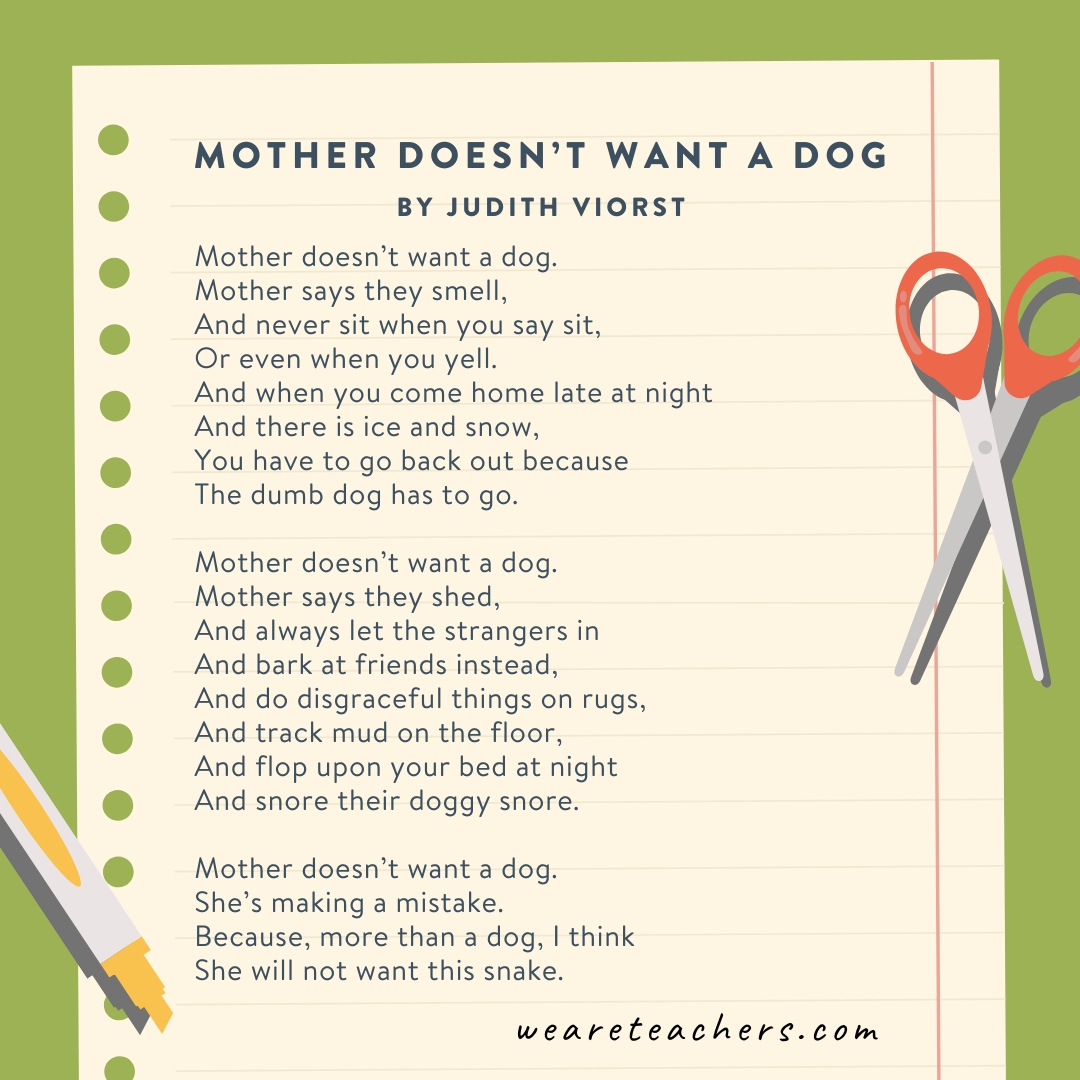
“Mom says they odor …”
Themes: Childhood, humor, household dynamics
Literary units: Rhyme, exaggeration, repetition
This humorous and relatable poem captures a baby’s frustration with their mother or father’s refusal to get a pet. It’s a terrific choose for discussing how humor is utilized in poetry, how rhyme enhances playful storytelling, and the way youngsters’ voices can shine via in writing.
“How doth the little crocodile / Enhance his shining tail …”
Themes: Deception, nature, satire
Literary units: Parody, rhyme, imagery
This intelligent poem is a parody of Isaac Watts’ moralistic poetry, changing a hardworking bee with a misleading crocodile. It’s excellent for discussing satire, poetic parody, and the way writers can subvert expectations of their work.
“For need of a nail, the shoe was misplaced.”
Themes: Penalties, trigger and impact, knowledge
Literary units: Repetition, parallel construction, aphorism
This well-known proverb-turned-poem teaches a lesson about how small actions can have large penalties. It’s nice for discussing trigger and impact, historic purposes (corresponding to in management or struggle), and the way repetition reinforces a message in poetry.
“Nobody can inform me / No one is aware of / The place the wind comes from / The place the wind goes.”
Themes: Curiosity, marvel, nature
Literary units: Rhyme, repetition, personification
This whimsical poem captures a baby’s curiosity concerning the wind and its mysterious actions. It’s a stunning piece for exploring how poetry embraces marvel and encourages college students to ask their very own large questions concerning the world.
48. The Swing by Robert Louis Stevenson
“How do you wish to go up in a swing / Up within the air so blue?”
Themes: Pleasure, childhood, motion
Literary units: Rhyme, repetition, imagery
This nostalgic poem fantastically captures the easy thrill of swinging, utilizing vivid imagery and rhythm to reflect the movement. It’s a terrific instance of how poetry can replicate the common experiences of childhood.
49. Magic by Shel Silverstein
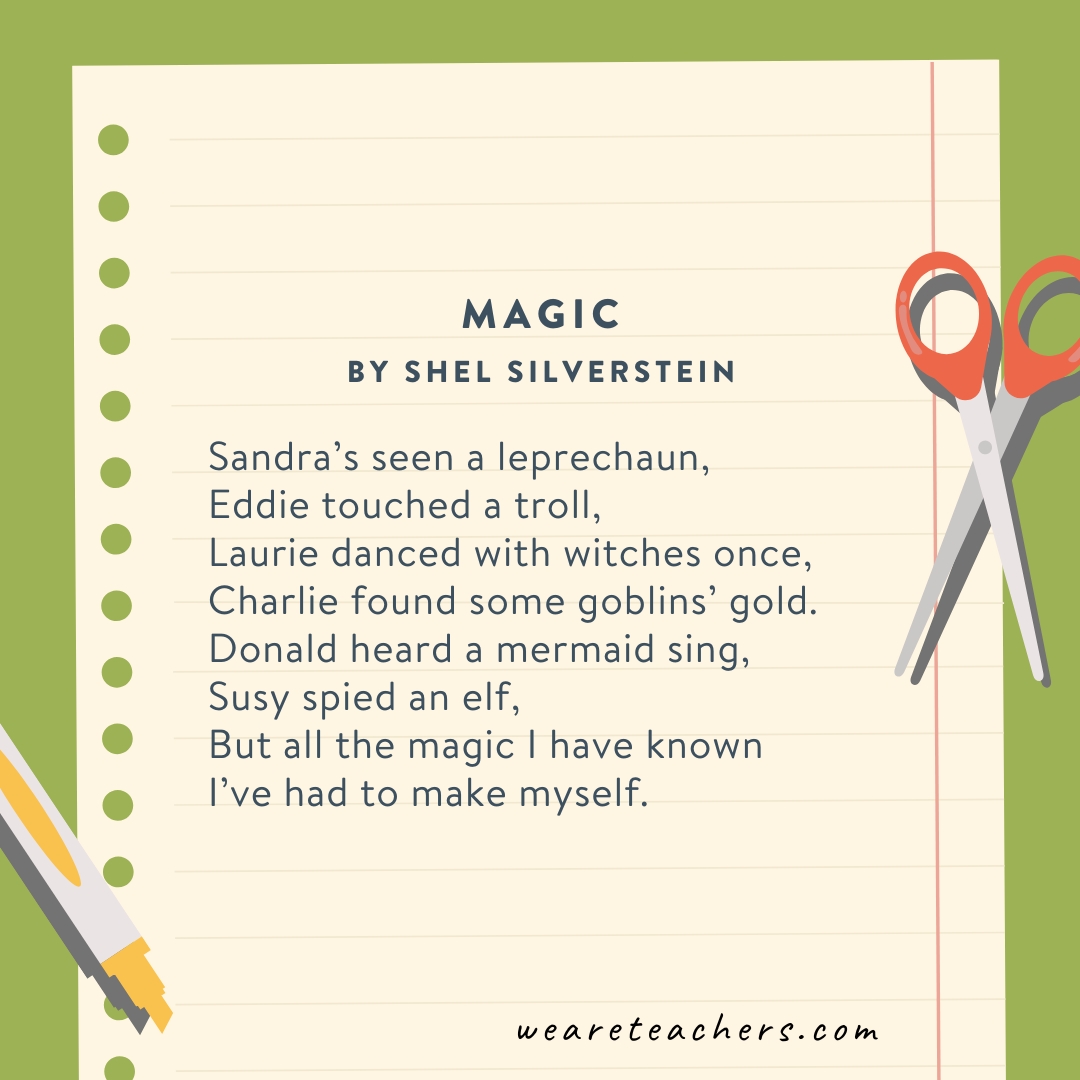
“Sandra’s seen a leprechaun …”
Themes: Creativeness, perception, marvel
Literary units: Rhyme, humor, playful tone
This enjoyable, imaginative poem embraces the concept magic exists for individuals who imagine in it. It’s excellent for discussions concerning the energy of perspective, artistic writing, and the way poets use playful language to interact younger readers.
“Two roads diverged in a yellow wooden / And sorry I couldn’t journey each …”
Themes: Decisions, individuality, life’s journey
Literary units: Metaphor, symbolism, rhyme
This well-known poem displays on decision-making and the affect of decisions on life’s path. It’s a terrific piece for discussing metaphor (the roads as life decisions), symbolism, and the way poetry can specific deep private reflection.
51. Fog by Carl Sandburg
“The fog comes on little cat ft.”
Themes: Nature, commentary, thriller
Literary units: Metaphor, imagery, personification
This brief however highly effective poem makes use of a easy metaphor to explain fog as a silent, creeping cat. It’s wonderful for discussing how poets use minimal phrases to create vivid imagery and evoke a selected temper.
“I by no means noticed a Purple Cow / I by no means hope to see one.”
Themes: Humor, absurdity, creativity
Literary units: Rhyme, irony, satire
This playful nonsense poem is a enjoyable technique to introduce humor in poetry and talk about how poets use exaggeration and absurdity to make a degree. It’s additionally nice for exploring rhyme and meter briefly verse.
53. Sick by Shel Silverstein
“My mouth is moist, my throat is dry / I’m going blind in my proper eye.”
Themes: Humor, exaggeration, childhood antics
Literary units: Hyperbole, rhyme, irony
This hilarious poem tells the story of a kid faking sickness to skip college, solely to appreciate it’s Saturday. It’s a strong instance of hyperbole and irony in poetry, making it a enjoyable piece to debate how poets use humor to interact readers.
“Mentioned the Duck to the Kangaroo / ‘Good gracious! the way you hop!’”
Themes: Friendship, journey, nonsense
Literary units: Rhyme, repetition, dialogue
This pleasant nonsense poem tells the quirky story of a duck and a kangaroo who wish to journey collectively. It’s a enjoyable technique to discover rhyme, rhythm, and the style of nonsense poetry whereas encouraging artistic storytelling.
55. Dreams by Langston Hughes
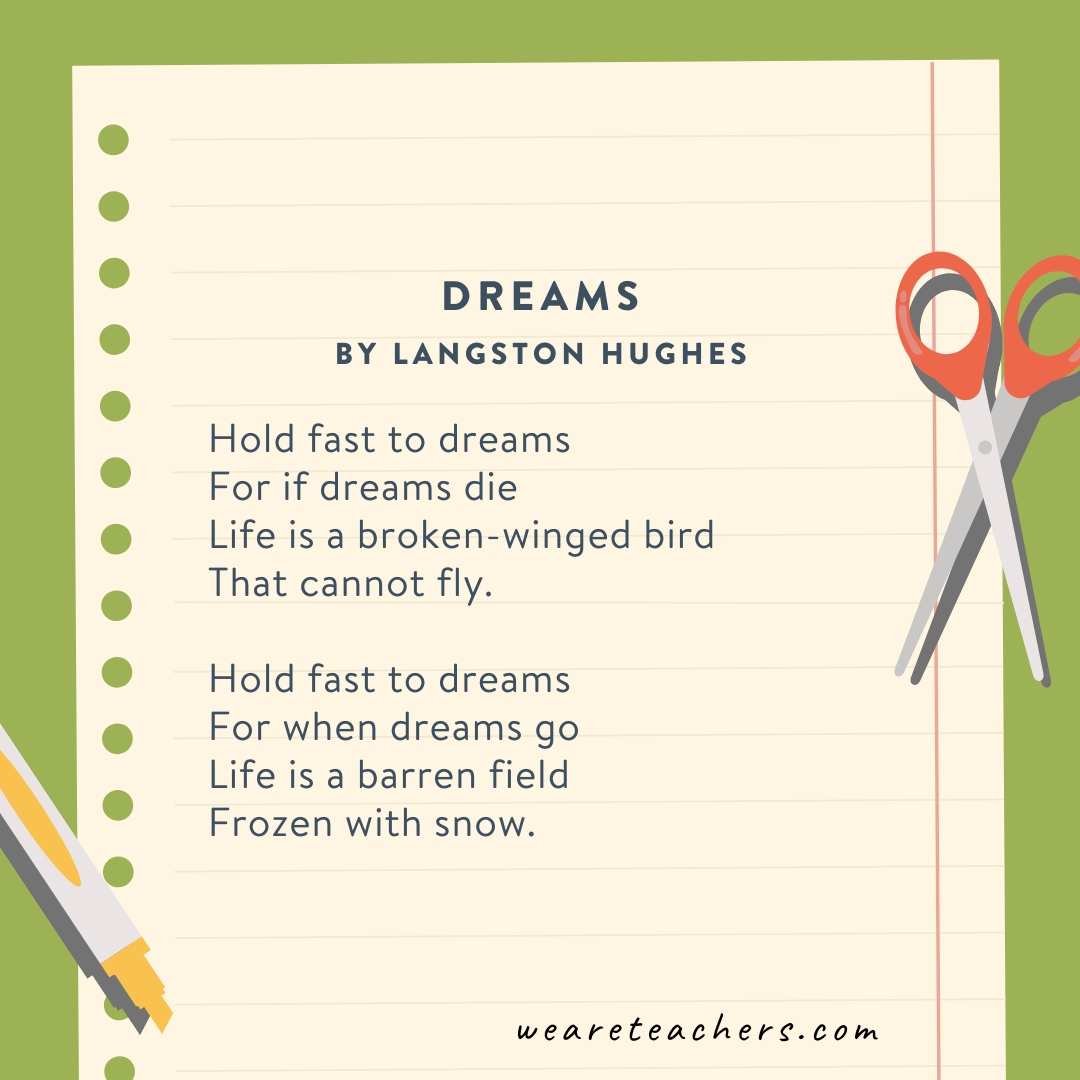
“Maintain quick to desires …”
Themes: Hope, perseverance, aspirations
Literary units: Metaphor, repetition, symbolism
This brief however significant poem encourages readers to carry onto their desires, utilizing sturdy metaphors to focus on their significance. It’s excellent for discussing figurative language, theme, and the way poetry can encourage resilience and ambition.
Get my free printable poetry worksheet bundle!
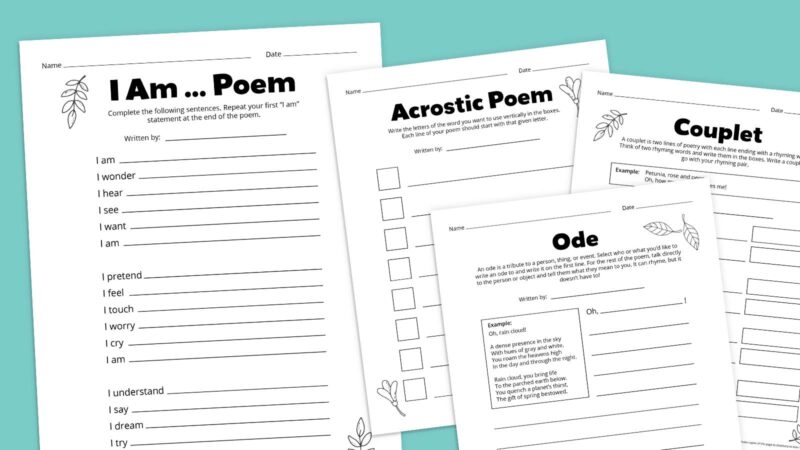
Are you able to deliver these actions to your classroom? Click on the button beneath to obtain our poetry worksheet bundle and get began!
In case you favored these poems for third graders, be sure you subscribe to our newsletters to seek out out when new articles like this are posted.
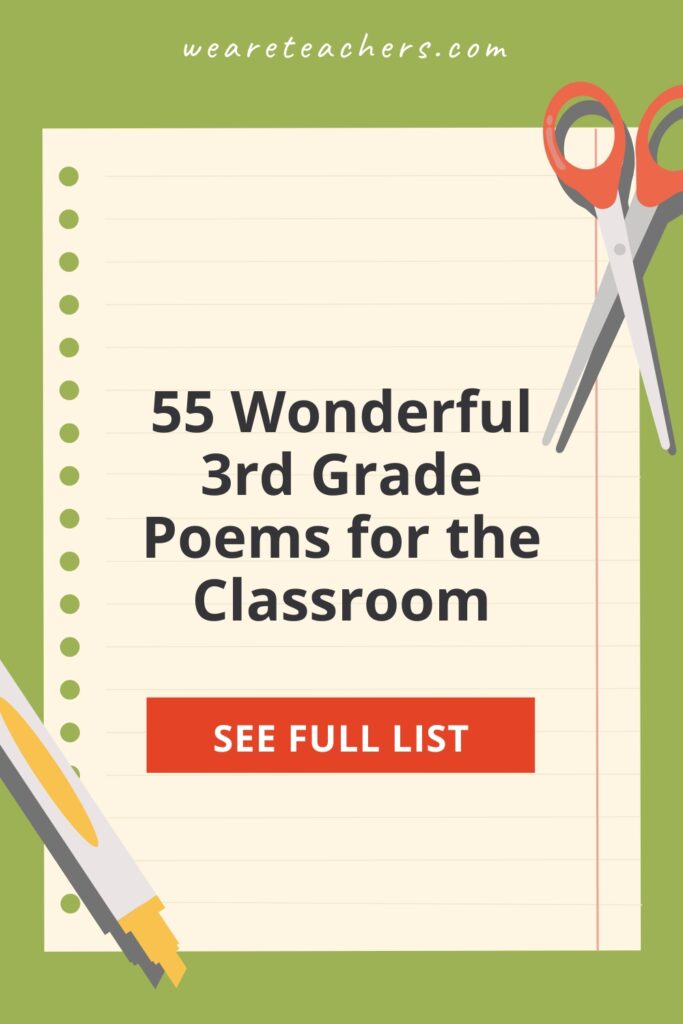
Trending Merchandise









